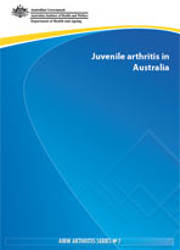Summary
Juvenile idiopathic arthritis is the general term used to describe inflammatory arthritis in children. An estimated 4,600 Australian children under the age of 16 had arthritis in 2004–05. Based on these self-reports, almost 22,000 adults had been diagnosed with arthritis in childhood. More common in girls, than in boys, juvenile arthritis, is estimated to be the main disabling condition for about 1,600 children. A large majority (83%) of children with this form of disability had severe activity limitation. Much disability was also noted in adults with disease onset in childhood.
Juvenile arthritis is not a ‘mini’ version of adult arthritis. Both its presentation and course are considerably different from those of the adult form of the disease. Because of its early onset, juvenile arthritis seriously affects the growth and development of the child. There is also a greater and long-term need for health care services throughout life in some cases. The burden of juvenile arthritis on the family is also high through reduced social interaction, role restrictions, and the cost of ongoing management and treatment. Some of the significant impacts of juvenile arthritis along its life course, based mostly on data from the 2004–05 National Health Survey and 2003 Survey of Disability, Ageing and Carers, both conducted by the Australian Bureau of Statistics (ABS) are given below.
Preliminary material: Acknowledgments; Abbreviations
Introduction
- What is juvenile arthritis?
- Juvenile vs adult arthritis
- History and classifications
- Monitoring juvenile arthritis
- This report
Nature of the problem
- The clinical problem
- Diagnosis
- Causal mechanisms and risk factors
- Prognosis, complications and comorbidity
Magnitude of the problem
- Incidence and prevalence
- Activity limitation
- Health care service use
- Mortality
Impact on growth, functioning and quality of life
- The experience of arthritis
- Long-term outcomes
- Juvenile arthritis and family
Treatment and management
- Management strategies
Appendixes
The International League Against Rheumatism classification of juvenile arthritis
Data sources
Definition of medical terms
End matter: References; List of tables; List of figures



